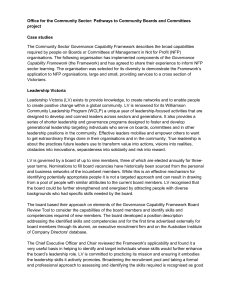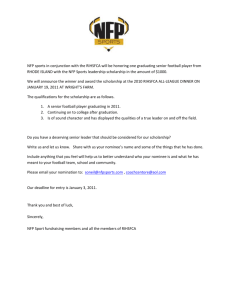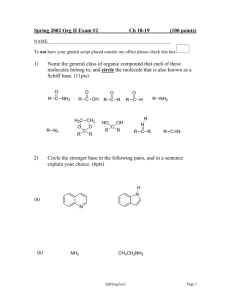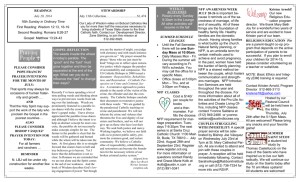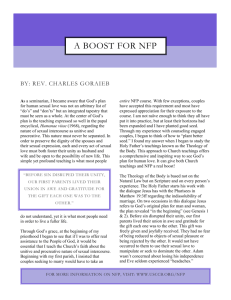NFP Site Visit Notes - Good Care Collaborative
advertisement
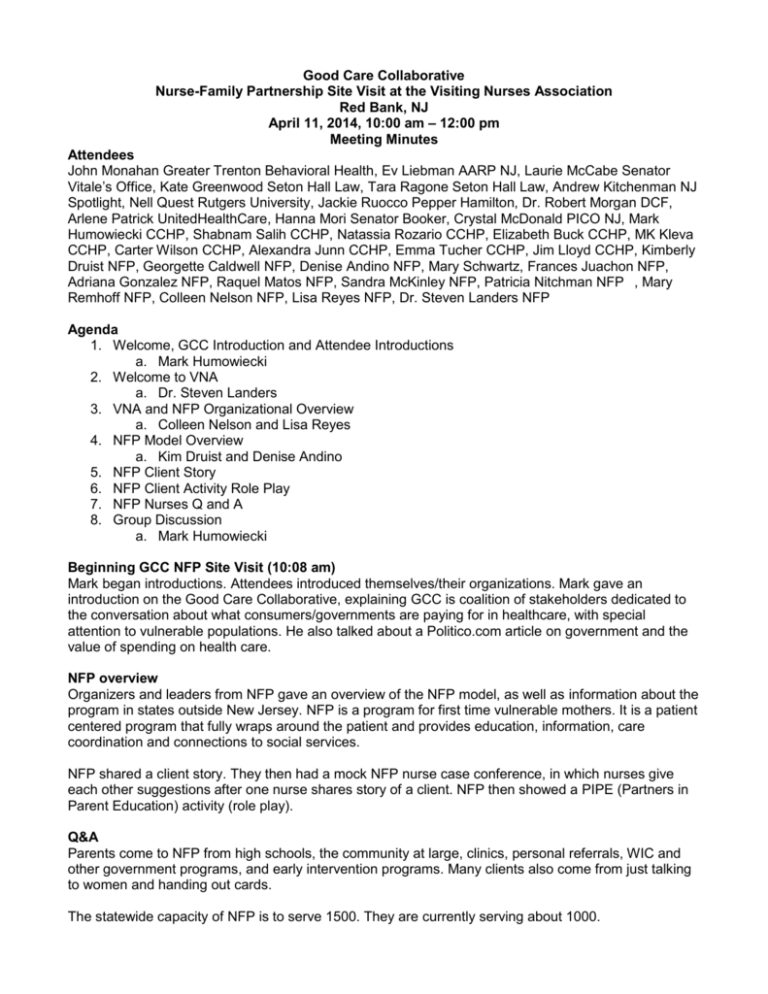
Good Care Collaborative Nurse-Family Partnership Site Visit at the Visiting Nurses Association Red Bank, NJ April 11, 2014, 10:00 am – 12:00 pm Meeting Minutes Attendees John Monahan Greater Trenton Behavioral Health, Ev Liebman AARP NJ, Laurie McCabe Senator Vitale’s Office, Kate Greenwood Seton Hall Law, Tara Ragone Seton Hall Law, Andrew Kitchenman NJ Spotlight, Nell Quest Rutgers University, Jackie Ruocco Pepper Hamilton, Dr. Robert Morgan DCF, Arlene Patrick UnitedHealthCare, Hanna Mori Senator Booker, Crystal McDonald PICO NJ, Mark Humowiecki CCHP, Shabnam Salih CCHP, Natassia Rozario CCHP, Elizabeth Buck CCHP, MK Kleva CCHP, Carter Wilson CCHP, Alexandra Junn CCHP, Emma Tucher CCHP, Jim Lloyd CCHP, Kimberly Druist NFP, Georgette Caldwell NFP, Denise Andino NFP, Mary Schwartz, Frances Juachon NFP, Adriana Gonzalez NFP, Raquel Matos NFP, Sandra McKinley NFP, Patricia Nitchman NFP , Mary Remhoff NFP, Colleen Nelson NFP, Lisa Reyes NFP, Dr. Steven Landers NFP Agenda 1. Welcome, GCC Introduction and Attendee Introductions a. Mark Humowiecki 2. Welcome to VNA a. Dr. Steven Landers 3. VNA and NFP Organizational Overview a. Colleen Nelson and Lisa Reyes 4. NFP Model Overview a. Kim Druist and Denise Andino 5. NFP Client Story 6. NFP Client Activity Role Play 7. NFP Nurses Q and A 8. Group Discussion a. Mark Humowiecki Beginning GCC NFP Site Visit (10:08 am) Mark began introductions. Attendees introduced themselves/their organizations. Mark gave an introduction on the Good Care Collaborative, explaining GCC is coalition of stakeholders dedicated to the conversation about what consumers/governments are paying for in healthcare, with special attention to vulnerable populations. He also talked about a Politico.com article on government and the value of spending on health care. NFP overview Organizers and leaders from NFP gave an overview of the NFP model, as well as information about the program in states outside New Jersey. NFP is a program for first time vulnerable mothers. It is a patient centered program that fully wraps around the patient and provides education, information, care coordination and connections to social services. NFP shared a client story. They then had a mock NFP nurse case conference, in which nurses give each other suggestions after one nurse shares story of a client. NFP then showed a PIPE (Partners in Parent Education) activity (role play). Q&A Parents come to NFP from high schools, the community at large, clinics, personal referrals, WIC and other government programs, and early intervention programs. Many clients also come from just talking to women and handing out cards. The statewide capacity of NFP is to serve 1500. They are currently serving about 1000. Is the care being integrated with the patient’s provider? ASQ scores are sent directly to providers; however, building trust with patients and raising confidence of moms is an additional piece. NFP is currently looking at how to integrate community programs, referrals, other programs, etc. NFP leadership explained that they’re more “cabinet makers” than they are “general carpenters,” meaning that their nurses have a specialized skill set for moms and moms to be. The priority is not to replace the “cabinet makers” of NFP with general contractors who cannot offer this specialized care. Case conferences take place biweekly as a team. NFP nurses alternate each week between team meetings and case conferences. There is a cycle so that each nurse has the opportunity to share stories and gather ideas for care from other nurses. The nurses’ supervisor meets with each nurse weekly. This evidence-based model has a demonstrated benefit — executing and adapting the model is essential. Ensuring experts are in every role is key to high performance. How does NFP keep fidelity to this model? Supervisors receive reports on activities to make sure progress is happening with each client. NFP is only beginning digital reporting and record keeping. A “fidelity report” looks at the 18 different key measures of the model and serves as outcome tracking, comparing each client to national/goal numbers. One important thing to consider with these is that each client is not the same as the people who participated in the Randomized Controlled Trial on NFP. Professionals at NFP work toward problem-solving for people whose situations may fall outside the norm, tracking outcomes, keeping true to the model, having good staff, and keeping attention to anomalies (and be flexible with them/creating specialized solutions). Rigorous research in Colorado studies the model and it continues to be innovative and adaptive, while still research-based and strong. The audience was very interested in learning that NFP is reimbursed through Medicaid payments in other states across the country. In NJ, NFP has shown that their program returns $5 in savings for every $1 spent. Breakout Sessions Participants broke into small groups comprised of members of different organizations. Discussion questions included what made NFP a model of “good care,” what lessons from the meeting could be brought back to participants’ organizations, and lessons from the day that would be a positive addition to health reform in New Jersey. Groups highlighted that NFP strengths include the fact that it is an evidence based program, they have strong outreach efforts and that they develop and hold dear patient and provider trust and relationship. Groups also brought up the question of how to pay for good, integrated care. The next GCC Site Visit will be at Henry J. Austin’s Ryan White HIV clinic in Trenton, NJ on Friday, May 21st, 10:00 am to 12:00 pm.

